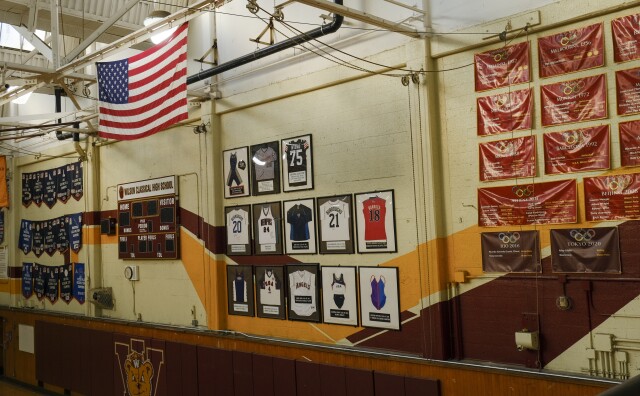Temperatures across Southern California once again stretched past 100 degrees on Monday, and remained warm Tuesday, with excessive heat warnings still in effect.
Many school districts announced limited schedules for students to begin the week, as the sun baked buildings not designed for extreme heat.
The Los Angeles Unified School District cut the day short at 12 schools, primarily in the San Fernando Valley. Torrance Unified sent its students home early.
“Many of our classrooms do not have air conditioning units,” a TUSD spokesperson said, “This decision prioritizes the health and safety of our students, staff, and community.”
She added that families are notified via text and email of changing conditions.
Midday at San Pedro High School, an intercom announcement reminded students where they could shelter during an excessive heat warning: “Good morning. The following cooling areas are available to students: the student cafeteria, the auditorium, and room 253 in the science building.”
The varying reactions demonstrate how many districts are straining to respond to increasing temperatures with limited capacity — and funding — for structural change. In the short term, that means trying to reduce students’ exposure to heat. In the long term, it means fixing schools built decades ago.
What is a ‘minimum day’?
Both Torrance and Los Angeles Unified called their modified schedules a “minimum day.”
A minimum day represents the fewest hours a school can teach students and still notch an instructional day; most California schools are required to have 180 instructional days in a school year. Minimum days are an alternative to having a full day off; a loss of instructional days means a potential loss of funding.
Another benefit to keeping warm schools open is that they might still be better than the alternative.
“Many families view schools as a safe and cooler environment, particularly in homes that lack air conditioning," said Elvia Cano, a Long Beach Unified spokesperson.
The minimum time required varies by age; younger children are less able to regulate their body temperatures than older students:
- 180 minutes for kindergarten
- 230 minutes for grades 1-3
- 240 minutes for grades 4-12
Classes often end by 2 p.m., if not earlier.
A Long Beach spokesperson said that the county or state need to make the call about whether to take an entire day off. LAist asked the Los Angeles County Office of Education about what the threshold would be to preempt a school day, but hadn’t heard back as of publication.
For students who aren’t able to go home early in the day, schools might offer supervision between end times and the start of scheduled after-school programs. District representatives suggested reaching out to a school's principal.
How do schools keep students, teachers, and staff cool?
Strategies revolve around a combination of keeping students out of the heat; using a variety of tactics to make classrooms feel cooler; and hydrating.
LAUSD has portable outdoor misting fans and pop-up tents at some elementary schools. Long Beach has equipped classrooms lacking A/C with chilled water dispensers and fans, and added window coverings to limit sunlight.
While districts like LAUSD have a policy that every classroom is air conditioned, that doesn’t always mean buildings are, which can leave staff — like cafeteria workers who already work in warm areas — exposed to heat.
How do schools handle outdoor activities and athletics?
Some SoCal schools are keeping students indoors during recess and have rescheduled games during this latest heatwave. A bill under consideration by Gov. Gavin Newsom would require all districts to create a plan to change on-campus activities like physical education during extreme weather.
And for organized sports, California schools now have to monitor the heat using a special thermometer that measures how heat stresses the human body by calculating the impact of the temperature, humidity, wind, and strength of the sun.
Above a certain reading, schools need to give students more breaks and more water, or cancel activities.
What’s the long-term outlook for keeping students safe from climate change?
About 84% of Long Beach schools are air-conditioned, a district spokesperson said. She added that the remaining schools are in the design or construction phase and should be finished within the next three years, except for Poly High School, which is due for more extensive renovations.
LAUSD earlier this year estimated 50,000 heating, ventilation and air conditioning (HVAC) units need to be replaced across the district, but this week declined to offer LAist data about repair requests during the heatwave. HVAC backlog issues have been a long-running issue in the district. And to beat the heat, it doesn’t help that LAUSD schools have a lot of blacktop; efforts to bring in more green space and shade are expected to take years, if not decades.
And that’s even if there’s money for all the necessary construction.
More than two dozen L.A. County school districts will ask voters to approve measures in the fall election asking for money to renovate buildings, including adding or replacing HVAC units.










